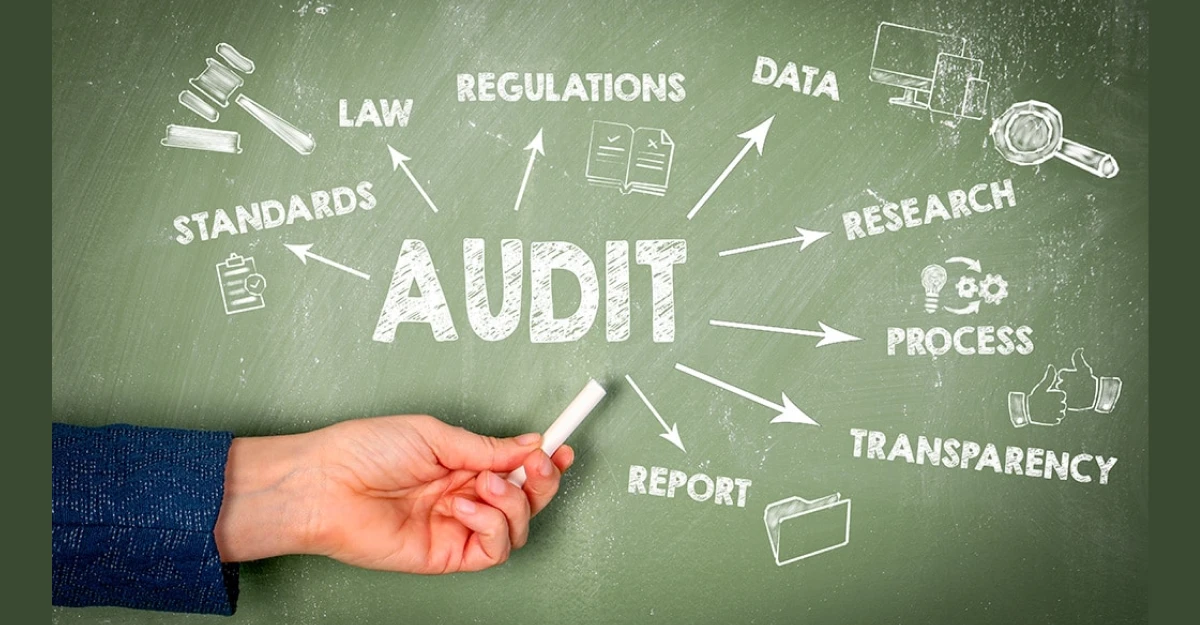World says that the Indian market is one of the toughest markets to conquer. So are the Indian business audits. If just one number gets misplaced, your entire maths will fall! Here comes the significance of the techniques of auditing. These techniques are like tools that help businesses check their finances.

You can picture this write-up as a guide to make sure everything adds up correctly and follows the rules. As we dive in, we’ll see how these auditing techniques play a crucial role in keeping businesses on the right track, ensuring their money matters are in order.
Stay tuned!
(A) What is Auditing?

Let’s begin with the definition of Auditing-
“Auditing is a systematic examination and verification of financial records, statements, or operations to ensure accuracy, compliance with regulations, and reliability of information for informed decision-making.”
Sounds too formal? Okay, let me explain!
In simple terms, auditing is like giving a thorough checkup on a company’s financial health. Just as a doctor examines a patient’s overall well-being, auditors carefully review a company’s financial records and operations to make sure everything is accurate and in good shape.
Imagine a bakery keeping track of its daily sales, expenses, and inventory. An auditor would verify that the reported numbers match the actual transactions. They might also assess if the bakery has proper systems in place to prevent errors or fraud.
In essence, auditing is like having a financial checkup for a business, ensuring everything adds up and follows the rules, much like a doctor ensuring a patient’s health is in order.
(B) How Auditing Works?
As you have read above, Auditing is nothing but a financial health check-up for a business. Let’s see how it works-
| Working Strategy | Concept | Explanation |
| Checking the Financial Records | Just as a doctor reviews your medical history, an auditor examines a company’s financial records, like invoices, receipts, and bank statements. | If a business claims to have made $100,000 in sales, the auditor checks if the records show the same. |
| Ensuring Accuracy | Like a doctor checks your vital signs, an auditor verifies that the financial numbers are accurate and not inflated or understated. | Example: If a company has Rs.10,00,000 in the bank, the auditor confirms this by checking the bank statements. |
| Compliance with Rules | Just as doctors follow medical guidelines, auditors ensure that a company follows financial rules and regulations. | If tax laws say a business should keep records for five years, the auditor makes sure they’re doing that. |
| Identifying Risks | Similar to how a doctor may warn you about potential health risks, auditors highlight the financial risks a company might face. | If a business relies heavily on one customer, the auditor might flag this as a risk if the customer stops buying. |
| Operational Efficiency | Like a doctor advising lifestyle changes for better health, an auditor suggests ways a company can operate more efficiently. | If a company is wasting money on unnecessary expenses, the auditor recommends cost-cutting measures. |
Auditing is about ensuring a company’s financial information is reliable, follows the rules, and helps the business stay healthy and successful.
(C) Types of Auditing
There are different types of auditing, each serving distinct purposes. Let’s have a look at them-
| Types of Auditing | Details |
| External Audit | Conducted by independent firms like KPMG or PwC. They check financial statements and advise on taxes, legal matters, and risks. These firms are separate from the companies they audit. Example: They review financial statements for accuracy. |
| Internal Audit | An independent service within a company. Aims to improve operations and assess controls. Internal auditors ensure the company follows rules and works efficiently. Example: They look at how internal processes can be better. |
| Forensic Audit | Investigate financial fraud or legal issues. Involves a detailed look at records and evidence. Used when there are suspicions or legal disputes. Example: Finding embezzlement or financial fraud. |
| Statutory Audit | Required by laws like the Companies Act in India. Ensures companies follow legal rules. These auditors report to regulators. Example: Yearly check for publicly listed companies. |
| Financial Audit | Focuses on checking if financial statements are accurate and complete. Makes sure financial data follows accounting standards. Gives confidence to stakeholders. Example: Checking balance sheets and income statements. |
| Tax Audit | Required by tax authorities to check if a company follows tax laws. Ensures accurate reporting of income and deductions. Example: An audit under tax laws to verify taxes. |
| Compliance Audit | Check if a company follows internal policies and external laws. Assesses if processes follow set guidelines. Example: Reviewing HR policies or safety protocols. |
You must remember that each type of audit has a specific purpose, making sure companies are transparent and accountable.
(D) 5 Most Used Techniques of Auditing for Businesses in India
There are several techniques employed in India by auditors to validate information and draw conclusions. Let’s explore the five most common techniques of auditing for businesses in India-
(D.1) Inquiry Auditing Technique
The Inquiry Auditing Technique is like conducting a conversation to gather information about how a business operates. Let’s have a closer look at it-
| Inquiry auditing technique | Details |
| Questioning Personnel | Auditors use interview-style questions with relevant staff in the organization. They inquire about business procedures, risk management steps, and how financial transactions are documented. |
| Insights and Limitations | While inquiry provides valuable insights into the company’s practices, it’s considered weaker evidence. |
| Example Scenario | For instance, auditors might ask business owners about where they keep important financial and data security documents. |
| Strengths and Weaknesses | Inquiry is used because it helps auditors understand the human side of business operations. However, it’s considered weaker evidence because it relies on people’s responses, which can be influenced by various factors. |
| Supplementing with Other Methods | Auditors are cautious and use inquiry alongside more reliable methods. By combining it with other auditing techniques, they strengthen the overall assessment. |
In essence, the Inquiry Auditing Technique involves auditors having discussions with key people to learn about how things work in the company. Although it provides valuable insights, auditors use it carefully, understanding its limitations, and complementing it with more robust auditing methods for a comprehensive evaluation.
(D.2) Observation Auditing Technique
The Observation Auditing Technique involves auditors actively watching and taking note of various activities, processes, and environmental factors within an organization. Let’s delve into the details in the following table-
| Observation Auditing Technique | Details |
| Active Observation | Auditors actively watch and take note of what’s happening in the organization. This can include observing how employees perform tasks, how processes are carried out, and the overall environment. |
| Documentation Lacking Control | This technique is particularly useful when there’s a lack of proper documentation for certain controls. Instead of relying solely on written records, auditors directly observe operations. |
| Traditionally Used in SOC Audits | On-site observation has traditionally been a part of System and Organization Controls (SOC) audits. They focus on controls related to information systems and data security. |
| Example Scenario | For instance, auditors might observe how specific records are stored or handled in the organization. |
| Benefits and Purpose | The benefit lies in directly witnessing processes and activities, providing a firsthand understanding. It’s particularly useful for evaluating controls or procedures that might not be well-documented. |
| Enhancing Assurance | Observation adds another layer of assurance, ensuring that what’s happening aligns with what’s documented. |
Thus, the Observation Auditing Technique involves auditors being present and actively watching how things unfold within the organization. It’s a valuable approach when certain controls lack proper documentation, offering auditors a firsthand view of operations. This technique is often applied in SOC audits, emphasizing the importance of directly observing processes and activities.
(D.3) Inspection or Examination of the Evidence Auditing Technique
The Inspection or Examination of the Evidence Auditing Technique involves a meticulous examination of relevant evidence, including financial statements, contracts, invoices, and other documentation.
Let’s delve into the details-
| Inspection or Examination of the Evidence Auditing Technique | Details |
| Thorough Examination | Auditors conduct a detailed review of various types of evidence, leaving no stone unturned. The goal is to ensure a comprehensive understanding of the financial landscape and related documents. |
| Types of Evidence Examined | Relevant evidence includes financial statements, contracts, invoices, and any documentation essential to the audit. Auditors inspect these documents to gain insights into the financial health and operational aspects of the organization. |
| Verification of Accuracy and Completeness | The primary objective is to verify the accuracy and completeness of the information presented in the documents. Auditors cross-check the data to ensure it aligns with the organization’s records and meets auditing standards. |
| Assessment of Reliability | By inspecting evidence, auditors assess the reliability of the data presented. This includes evaluating the source, authenticity, and integrity of the documents to ensure their trustworthiness. |
| Identification of Discrepancies | Auditors keenly look for any discrepancies or inconsistencies in the evidence examined. This involves comparing financial statements with supporting documents to identify potential errors or irregularities. |
| Example Scenario | For instance, in the inspection of invoices, auditors may compare them with corresponding purchase orders and delivery receipts to ensure accurate recording of transactions. |
| Holistic Understanding | Inspection of evidence provides auditors with a holistic understanding of the organization’s financial transactions and operations. It aids in forming a complete and accurate picture, crucial for a reliable audit. |
| Risk Mitigation | This technique serves as a robust risk mitigation strategy by directly addressing the reliability of evidence. Auditors can identify and rectify issues early in the process, reducing the likelihood of errors or fraud going unnoticed. |
In short, the Inspection or Examination of the Evidence Auditing Technique involves a thorough review of relevant documents to ensure accuracy, completeness, and reliability. By scrutinizing financial statements, contracts, and invoices, auditors gain insights into the organization’s financial health while actively mitigating risks associated with potential discrepancies or inaccuracies.
(D.4) Re-Performance Auditing Technique
The Re-Performance Auditing Technique entails auditors independently redoing computations or processes that were initially performed by the organization.
| Re-Performance Auditing Technique | Details |
| Independent Redoing | Auditors, during re-performance, independently repeat calculations or processes carried out by the organization. This ensures a fresh examination of the accuracy of financial activities. |
| Verification of Calculations | The primary focus is on verifying the precision of calculations conducted by the company. Auditors may re-perform various mathematical computations to confirm their accuracy. |
| Reconciliation Verification | Re-performance extends to verifying reconciliations conducted by the organization. This involves independently checking whether financial statements align and match corresponding records. |
| Ensuring Consistency | Auditors use re-performance to ensure consistency and reliability in financial transactions. For instance, they may re-perform a sample of transactions to confirm that the company’s calculations are consistent with the audit standards. |
| Example Scenario | Suppose a company has calculated its revenue for the year. Auditors employing re-performance may independently redo a sample of revenue calculations to ensure accuracy and consistency. |
| Risk Mitigation | Re-performance serves as a risk mitigation strategy by providing auditors with a direct method to validate financial figures. It acts as a safeguard against potential errors or discrepancies that may have occurred during the initial calculations. |
| Comprehensive Verification | This technique contributes to a comprehensive verification process by independently validating key financial activities. It enhances the reliability of financial information presented by the organization. |
In short, Re-Performance in auditing involves auditors independently redoing calculations and processes conducted by the organization. By focusing on the accuracy of computations, reconciliation verification, and ensuring consistency, this technique enhances the overall reliability and precision of financial information, contributing to a thorough audit process.
(D.5) Computer-Assisted Audit Technique (CAAT)
CAAT, or Computer Assisted Audit Technique, involves leveraging technology and specialized software tools to enhance the audit process.
| Computer-Assisted Audit Technique (CAAT) | Details |
| Technology Integration | CAAT integrates technology into the audit process, utilizing specialized software tools designed for data analysis. |
| Data Analysis | Auditors using CAAT analyze large volumes of data with the help of computer programs. This involves performing data analytics to extract valuable insights, identify patterns, and detect anomalies. |
| Efficiency Enhancement | CAAT is designed to streamline the audit process, making it more efficient and effective. By automating certain tasks, auditors can focus their efforts on areas with higher risks. |
| Identifying Patterns and Anomalies | Through data analysis, CAAT helps auditors identify patterns that could indicate normal business operations. It also highlights anomalies or irregularities that might require further investigation. |
| Efficient Focus on High-Risk Areas | CAAT allows auditors to concentrate on high-risk areas by automating routine procedures. This targeted focus improves the audit’s effectiveness in uncovering potential issues. |
| Example Scenario | For instance, using CAAT, auditors can analyze a large dataset of financial transactions to quickly identify unusual patterns or discrepancies. |
| Benefits of CAAT | Increases the speed and accuracy of the audit process. Enables auditors to handle larger datasets that would be impractical to review manually. Enhances the ability to detect fraud, errors, or areas of non-compliance. |
Thus, CAAT represents a modern approach to auditing, leveraging technology to efficiently analyze large datasets. By automating tasks and focusing on data analytics, auditors using CAAT enhance their ability to identify patterns, anomalies, and potential risks, ultimately improving the overall effectiveness of the audit process.
(E) Significance: Why do the techniques of Auditing matter?
The techniques of auditing play a crucial role in ensuring the integrity, accuracy, and reliability of financial information within businesses. Let’s delve into why these techniques matter in Indian businesses-
| Significance of Techniques of Auditing | Details |
| Verification and Validation | Auditing techniques allow auditors to verify the accuracy of financial records, transactions, and other relevant data. By validating information through techniques like inspection, re-performance, and observation, auditors ensure that financial statements reflect the true financial position of the organization. |
| Risk Assessment | Auditors use these techniques to assess risks associated with financial processes. For instance, inquiry helps identify potential control weaknesses or gaps in internal procedures. By understanding risks, businesses can take corrective actions to mitigate them. |
| Compliance and Legal Requirements | Auditing techniques help businesses comply with legal and regulatory requirements. Accurate financial reporting is essential for tax compliance, investor confidence, and legal obligations. Techniques like inspection and examination ensure adherence to accounting standards. |
| Fraud Detection and Prevention | Auditors use techniques to detect fraudulent activities. Re-performance and data analytics (CAAT) help uncover irregularities or suspicious patterns. Detecting fraud early prevents financial losses and maintains a business reputation. |
| Operational Efficiency and Effectiveness | Auditing techniques evaluate the efficiency and effectiveness of internal controls and processes. Observations and inquiries reveal areas for improvement. Businesses can enhance operations based on audit findings. |
| Stakeholder Confidence | Reliable financial information builds stakeholder confidence. Investors, lenders, and shareholders rely on audited statements. Properly executed techniques enhance transparency and trust. |
Thus, auditing techniques matter because they safeguard financial accuracy, manage risks, ensure compliance, and contribute to overall business success.
Note: We have thoroughly explained the concept “Economic Profit vs Accounting Profit: Difference & Examples.” Go through the article for detailed information.
(F) Wrapping up the techniques of Auditing

Now, let’s wrap up. Auditing is a vital compass guiding businesses through financial complexities in India. The techniques of auditing collectively form a robust framework ensuring accuracy, compliance, and operational efficiency.
Whether it’s adhering to legal requirements, evaluating internal controls, or uncovering financial irregularities, these techniques serve as guardians of transparency and accountability.
By employing these strategies, businesses navigate the diverse economic landscape, fostering trust among stakeholders and securing a resilient foundation for sustained success in the dynamic Indian business environment.


Agree, having a deep understanding about auditing in business landscape in today’s time is must!